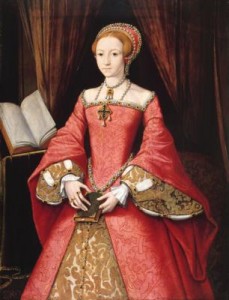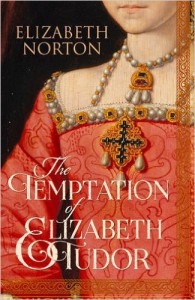 A big welcome to historian Elizabeth Norton who joins us today for a guest post on the subject of her latest book The Temptation of Elizabeth Tudor. Over to Elizabeth…
A big welcome to historian Elizabeth Norton who joins us today for a guest post on the subject of her latest book The Temptation of Elizabeth Tudor. Over to Elizabeth…
June 1547. The court of Edward VI was stunned by the news that the queen dowager – Catherine Parr – had married the boy king’s uncle. The bridegroom, Thomas Seymour, had eagerly sought a royal bride. He was already disaffected with an unequal share of power, which saw his elder brother become both Lord Protector and governor of the king. After first proposing matches with the two princesses, Mary and Elizabeth, he had settled on their stepmother, joining her household at Chelsea that month.
On entering a household still draped in mourning black for Henry VIII, Thomas found his wife’s thirteen year old stepdaughter, Princess Elizabeth. When Queen Catherine married Thomas, along with the promise in the conventional marriage vows that she would be ‘buxom’ in bed, she vowed to obey him. The fact of her marriage allowed him dominance over every aspect of her person for, as a married woman, she ceased to exist independently in law. Everything that married women owned, down to the clothes on their backs, passed to their husbands, to whom wives were utterly subject. As well as regularly helping himself to his wife’s generous widow’s pension, Seymour also arrived at Chelsea as the house’s new master. No door was locked against him – he held a key to them all.
The first sign of Thomas’s interest in Elizabeth was a dramatic one. Not long after he arrived a Chelsea, he entered her bedchamber for the first time in the early morning, pulling back the bed-curtains with his hand. Leaning into the bed, he called ‘good morrow’, before seeming to pounce, as though he would climb in with her. Stunned and blushing, Elizabeth shrank deeper into the bed, ‘so that he could not come at her’. It was to be the first of many such visits with the girl. On one occasion, the princess who was (as she admitted) ‘no morning woman’, made an effort to rise early, not wanting to be caught by surprise. Yet, he still came, appearing in the doorway dressed in a short night-gown, ‘barelegged and in his slippers’, before again bidding her ‘good morrow’ and asking ‘how she did’. As Elizabeth turned to move away, Thomas reached out to smack her on the back and then ‘familiarly’ on her buttocks. For a girl who blushed even to brush hands with her stepmother’s husband when dancing, this was startling. She fled to her maidens, but Seymour followed, speaking playfully with the girl’s attendants as if nothing were amiss.
The danger to Elizabeth’s reputation of such conduct was very real. Although she was pale skinned and fair like her father, in most other respects she resembled her captivating mother. The princess was fascinated by the mother she could probably not remember, later hiding Anne Boleyn’s portrait in a secret compartment in a ring. But, as the daughter of ‘such a mother’, Elizabeth was expected by many to behave with the impropriety with which her mother had been accused.
The girl’s lady mistress, Kate Ashley, who had once encouraged Seymour’s suit, recognised the danger. She had earlier moved the pallet bed from Elizabeth’s bedchamber at Chelsea so that the girl slept dangerously unchaperoned. This had probably been done so that Kate could share a bed with her husband, rather than constantly supervising the girl, but it looked suspicious. As Seymour’s visits increased, Kate confronted him in the gallery at Hanworth, where the household moved later in the summer. Berating Thomas, she stated that ‘these things were complained of, and that My Lady was evil spoken of’. Seymour was having none of it, swearing fiercely ‘God’s precious soul!’, before declaring that ‘he would tell My Lord Protector how it slandered him, and he would not leave it, for he meant no evil’. There was little else she could do.
Catherine Parr, too, failed to protect Elizabeth from Seymour’s growing interest. She was a woman of great passions, but was under Thomas’s thumb, anxious to do nothing to antagonise him even if this meant persuading herself to look the other way. Seymour expected his wife to do as she had promised and obey her husband. He would even start petty quarrels as a means of testing her devotion and her willingness to submit. Once, in the highly charged summer of 1547, he accused her of infidelity after finding the door to Catherine’s chamber shut just before a groom emerged, carrying a coal basket. Although he later claimed to be feigning jealousy, Seymour flew into a rage.
He was rumoured to be an ‘oppressor’ in his domestic arrangements, and Catherine, though she loved him, dared not vex him. The most she would do was join in some of the early morning romps herself, perhaps in an attempt to convince herself that all was as it should be. Nonetheless, she also admonished Kate to keep a closer eye on her charge while, in the autumn of 1547, she left Elizabeth behind at Hanworth when the household moved to London in time for the opening of parliament. She could not keep them apart indefinitely, however. On finding the pair locked in an embrace in June 1548, she finally sent the girl away.
 For propriety’s sake, Thomas accompanied Elizabeth part of the way to Cheshunt, where it had been hurriedly arranged that she would stay. While the pair never met again, this was far from the end of the story of his temptation of Elizabeth Tudor. On 5 September 1548, the thirty-six year old queen died in childbirth, leaving Thomas Seymour, once again, ‘the noblest man unmarried in this land’. He had no plans to remain that way for long, with his thoughts – and his ambitions – turning squarely towards Elizabeth.
For propriety’s sake, Thomas accompanied Elizabeth part of the way to Cheshunt, where it had been hurriedly arranged that she would stay. While the pair never met again, this was far from the end of the story of his temptation of Elizabeth Tudor. On 5 September 1548, the thirty-six year old queen died in childbirth, leaving Thomas Seymour, once again, ‘the noblest man unmarried in this land’. He had no plans to remain that way for long, with his thoughts – and his ambitions – turning squarely towards Elizabeth.
Thank you, Elizabeth, for such a wonderful article. I have just reviewed Elizabeth’s book over on our review site – click here to read it now. It’s a brilliant read and I highly recommend it.
The Temptation of Elizabeth Tudor is available in the US on Kindle and to pre-order as a hardback – click here, and as a hardback and kindle in the UK – click here.
Changing the subject… If you fancy making a Tudor lambswool/wassail as a change from mulled wine then do check out my video over at the Tudor Society – click here to view it now.